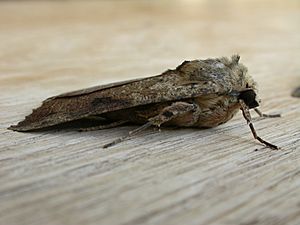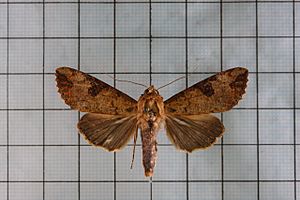Cacao armyworm facts for kids
Quick facts for kids Cacao armyworm |
|
|---|---|
 |
|
 |
|
| Scientific classification | |
| Kingdom: | |
| Phylum: | |
| Class: | |
| Order: | |
| Family: | |
| Genus: |
Tiracola
|
| Species: |
T. plagiata
|
| Binomial name | |
| Tiracola plagiata (Walker, 1857)
|
|
| Synonyms | |
|
|
The cacao armyworm, known scientifically as Tiracola plagiata, is a type of moth. It belongs to the family Noctuidae, which includes many kinds of owlet moths. This moth was first described by Francis Walker in 1857. You can find the cacao armyworm in many places, from Southeast Asia, South India, Sri Lanka, and Myanmar all the way to the South Pacific Islands. It also lives in the northern two-thirds of Australia.
What Does It Look Like?
The cacao armyworm moth has a wingspan of about 60 millimeters (about 2.4 inches). Male moths have tiny hairs on their antennae. The edges of their front wings have a jagged, tooth-like look.
The moth's body is a light grayish-brown, and its belly (abdomen) is dark brown. The front wings often have a reddish-brown color, sprinkled with dark brown spots. Sometimes, you can see a faint, wavy line near the base of the front wings. Other markings, like the orbicular and reniform spots, are usually hard to see. They might be yellowish or dark brown. Faint traces of curved black dots can be seen across the wings. Near the outer edge, there's a yellowish, double-curved line and a row of black dots along the very edge. Their back wings are dark brown with whitish edges.
Caterpillar and Pupa
The caterpillar (larva) of the cacao armyworm is a dull violet-brown color. It has a few thin hairs on its back. You might also see some scattered gray dots and a light olive-green stripe along its side. This stripe starts from its fourth body segment. The caterpillar's head and legs are violet-gray. Its head is small, and its last body segment is shaped like a cone. When the caterpillar turns into a pupa, it is dark red.
Where Does It Live and What Does It Eat?
The cacao armyworm is known as a pest that can harm many fruit trees and other plants around the world. It especially likes to eat Musa acuminata, which is a type of banana.
Caterpillars of the cacao armyworm have also been found eating other plants. These include different kinds of Dioscorea (yams), Diplocyclos palmatus, Toona australis (Australian red cedar), Eucalyptus trees, Portulaca oleracea (purslane), Phytolacca octandra, Theobroma cacao (the plant that gives us chocolate), Coffea arabica (coffee plants), and Physalis ixocarpa (tomatillo).


